I'm creating a tool that detects sprites in a sprite sheet and converts each found sprite into a new BufferedImage. This process works, but is prohibitively slow with certain image formats- mostly transparent images- such as this one:
(Kenney's Game Assets - Animal Pack)
I have profiled my code and determined that the vast majority, by over 99% of my app time is spent in this method alone because of the many getRGB() calls.
private fun findContiguousSprite(image: BufferedImage, startingPoint: Point, backgroundColor: Color): List<Point> {
val unvisited = LinkedList<Point>()
val visited = arrayListOf(startingPoint)
unvisited.addAll(neighbors(startingPoint, image).filter {
Color(image.getRGB(it.x, it.y)) != backgroundColor
})
while (unvisited.isNotEmpty()) {
val currentPoint = unvisited.pop()
val currentColor = Color(image.getRGB(currentPoint.x, currentPoint.y))
if (currentColor != backgroundColor) {
unvisited.addAll(neighbors(currentPoint, image).filter {
!visited.contains(it) &&
!unvisited.contains(it) &&
(Color(image.getRGB(it.x, it.y)) != backgroundColor)
})
visited.add(currentPoint)
}
}
return visited.distinct()
}
I have attempted to optimize the process of extracting rgb colors as seen in the question Java - get pixel array from image by accessing the image's raster data buffer, but this fails in the newest versions of Java with a java.lang.ClassCastException: java.awt.image.DataBufferInt cannot be cast to java.awt.image.DataBufferByte.
Other stumbling blocks include the deceitfully needless boxing of colors such as in the line Color(image.getRGB(it.x, it.y)) != backgroundColor. However, while image.getRGB() returns by default in the RGBA color space, background.rgb only returns the sRGB color space.
Question: How can I improve the performance of reading a BufferedImage especially in the case of transparent images? Why is it so fast with almost any other .png image I throw at it except for these?
Note: While the code is in Kotlin, I accept Java or any other JVM language as an answer.
Code dump: In case you want the full section of code:
private fun findSpriteDimensions(image: BufferedImage,
backgroundColor: Color): List<Rectangle> {
val workingImage = image.copy()
val spriteDimensions = ArrayList<Rectangle>()
for (pixel in workingImage) {
val (point, color) = pixel
if (color != backgroundColor) {
logger.debug("Found a sprite starting at (${point.x}, ${point.y})")
val spritePlot = findContiguousSprite(workingImage, point, backgroundColor)
val spriteRectangle = spanRectangleFrom(spritePlot)
logger.debug("The identified sprite has an area of ${spriteRectangle.width}x${spriteRectangle.height}")
spriteDimensions.add(spriteRectangle)
workingImage.erasePoints(spritePlot, backgroundColor)
}
}
return spriteDimensions
}
private fun findContiguousSprite(image: BufferedImage, startingPoint: Point, backgroundColor: Color): List<Point> {
val unvisited = LinkedList<Point>()
val visited = arrayListOf(startingPoint)
unvisited.addAll(neighbors(startingPoint, image).filter {
Color(image.getRGB(it.x, it.y)) != backgroundColor
})
while (unvisited.isNotEmpty()) {
val currentPoint = unvisited.pop()
val currentColor = Color(image.getRGB(currentPoint.x, currentPoint.y))
if (currentColor != backgroundColor) {
unvisited.addAll(neighbors(currentPoint, image).filter {
!visited.contains(it) &&
!unvisited.contains(it) &&
(Color(image.getRGB(it.x, it.y)) != backgroundColor)
})
visited.add(currentPoint)
}
}
return visited.distinct()
}
private fun neighbors(point: Point, image: Image): List<Point> {
val points = ArrayList<Point>()
val imageWidth = image.getWidth(null) - 1
val imageHeight = image.getHeight(null) - 1
// Left neighbor
if (point.x > 0)
points.add(Point(point.x - 1, point.y))
// Right neighbor
if (point.x < imageWidth)
points.add(Point(point.x + 1, point.y))
// Top neighbor
if (point.y > 0)
points.add(Point(point.x, point.y - 1))
// Bottom neighbor
if (point.y < imageHeight)
points.add(Point(point.x, point.y + 1))
// Top-left neighbor
if (point.x > 0 && point.y > 0)
points.add(Point(point.x - 1, point.y - 1))
// Top-right neighbor
if (point.x < imageWidth && point.y > 0)
points.add(Point(point.x + 1, point.y - 1))
// Bottom-left neighbor
if (point.x > 0 && point.y < imageHeight - 1)
points.add(Point(point.x - 1, point.y + 1))
// Bottom-right neighbor
if (point.x < imageWidth && point.y < imageHeight)
points.add(Point(point.x + 1, point.y + 1))
return points
}
First Optimization
Driven by @Durandal's comment, I decided to change my ArrayList to a HashSet. I also found a way to preserve alpha values using an alternative constructor for Color, Color(rgb, preserveAlpha). Now I no longer need to box getRGB() before comparing the two values.
private fun findContiguousSprite(image: BufferedImage, point: Point, backgroundColor: Color): List<Point> {
val unvisited = LinkedList<Point>()
val visited = hashSetOf(point)
unvisited.addAll(neighbors(point, image).filter { image.getRGB(it.x, it.y) != backgroundColor.rgb })
while (unvisited.isNotEmpty()) {
val currentPoint = unvisited.pop()
val currentColor = image.getRGB(currentPoint.x, currentPoint.y)
if (currentColor != backgroundColor.rgb) {
unvisited.addAll(neighbors(currentPoint, image).filter {
!visited.contains(it) &&
!unvisited.contains(it) &&
image.getRGB(it.x, it.y) != backgroundColor.rgb
})
visited.add(currentPoint)
}
}
return visited.toList()
}
This processed the above image in 319ms. Awesome!
